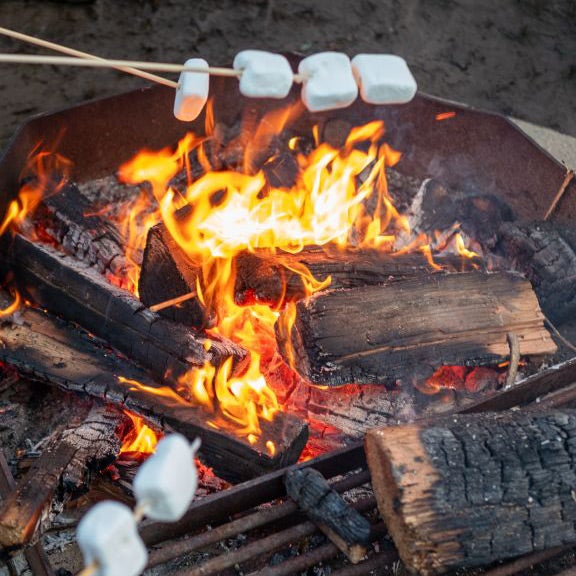Every great campfire is built using three materials: fuel, flame, and air. Simple enough, right? But in spite of the fact that we had a lighter, a large metal fire pit, and an Eagle Scout on our camping trip, our group of five seasoned outdoorsmen couldn’t get a fire started on a cold December night near Death Valley last year.
Our resident scout had the right idea: He piled a mound of dry grass in the pit, then built a tiny log cabin-style structure of chopstick-sized kindling he’d gathered around the mound. He had a stack of slightly larger pieces of dried wood at the ready to toss in once his framework caught fire. He lit the grass with a lighter. We all held our breaths.
It worked! Until it didn’t. An overeager member of our group dropped in too-large cuts of wood, smothering the nascent flame. In spite of the ample kindling around us, stubbornness trumped logic and we decided to blow on the weak embers for the next 30 minutes—a futile exercise. The fire never returned. Smores dreams ruined. We went to bed cold and grumpy.
Not allowing a fire to grow to a substantial size before throwing in the big stuff is one of the most common mistakes that new campfire-builders make. Whether you are a complete novice or a seasoned fire starter, below are some tips and best practices on how to start a fire when it counts.
How to Start a Fire
For Beginners:
Step 1: Gather Wood
You’ll need small, medium, and larger pieces of wood. You’ll also need a few handfuls of small kindling—think toothpick sized twigs and dried pine needles. It’s better to have too much than too little of the small stuff.
Step 2: Build A Structure
Place something that will burn well, like balled-up newspaper, at the center of the fire pit, then build a small structure of your kindling around it. There is an age-old debate over whether the log cabin (twigs stacked in an ascending square shape) or the teepee (twigs leaned against each other in a cone shape) is more effective. The short answer is: They both work. Just make sure whichever structure you create offers plenty of space in the center to give the fire air.
Step 3: Light It, And Wait
Light the material inside the structure, then sit back and be patient. Blow on the flame a bit to stoke it if need be, and add a few of the smaller sticks in your firewood collection, but give your creation at least a couple of minutes to grow before adding larger sticks. Blowing too hard on a small flame with extinguish it, as will tossing on the larger logs.
Step 4: Add Big Logs Slowly
Once your fire is consuming forearm-thick sticks, drop one or two larger logs on there, gently, one at a time. Don’t throw them on there or you risk destroying all you’ve built!
Step 5: Relax
Sit back and enjoy. Once the fire is going it doesn’t need constant maintenance.
For Experts:
You’ve got 100 successful campfires under your belt and you’re ready to take it up a notch. You want to get good enough to be able to strike up a fire on a backpacking trip without newspaper or a lighter. But while starting a fire with a bow-drill or another friction method sounds really sexy, it takes real training and a great deal of practice to become proficient. Unless you plan to learn from a professional survival instructor and plan to up on the skills, we don’t suggest depending on them.
Instead, start by practicing the one-match fire, which is pretty much what it sounds like: confining yourself to a single match to start your next campfire. If you can consistently build fires using only one match, it is a great indicator that you will be able to make a potentially life-saving fire when it counts. Make a ton of them—safely of course—and when it gets easy, add little challenges like using wet kindling or less starter material. Learning how to coax a fire out of sub optimal fuel is fun when it is in your fire pit and the stakes are low, but you can take that knowledge and use it in the field when you are cold and potentially desperately need the heat.
Pro Tip: Don’t Forget About Starter
As a contingency plan, when you’re preparing for a wilderness trip, pack a Ziplock with cotton balls soaked in petroleum jelly. They work as starter material in a pinch. Simply pick out a cotton ball, pull it apart so it has some loft, and light it. They’re surprisingly robust. I have had one burn for more than a minute in a rainstorm, which made the difference between us going to bed warm or going to cold that evening.


